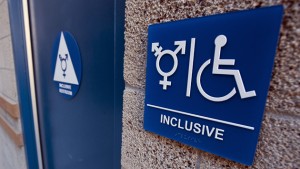Are Public Bathrooms Really ‘Accommodating’? : A Summary of Emily Bazelon’s Article
In Emily Bazelon’s article “Making Bathrooms More Accommodating”, she argues that public bathrooms should be more “accommodating” to fit the needs of all groups of people, and not just the socially constructed genders, male and female. She begins by giving insight on the struggles that transgender people have when they have to which restroom to enter. It is difficult for them because their only options are “Men” and “Women.” Bazelon states that if they enter and the people inside “think [they’ve] confused male and female and walked through the wrong door, [they] risk discomfort, or even real trouble.” She argues that this is because the gender categories which determine who can enter the restrooms are “fixed.” According to Bazelon, the idea of “mixing male and female anatomy in [multi-stall] bathrooms and locker rooms” is a touchy subject for a lot of people. In Houston, a law that “protected against discrimination in housing and employment, [due to] race, age ,sexual orientation and gender identity” was voted against and given the nickname, the “bathroom ordinance”. The “opponents” of the law even made shirts with images of a man threatening a girl in the bathroom, in order to discourage people from supporting the law, by “playing on voters’ fears.”
To take her argument a step further, Bazelon provides a story of a transgender teenager, male to female, at a high school in Illinois, who was not allowed to change in the girls’ locker room because of privacy concerns”. Instead, she was sent down the hall to a separate room. Her parents brought a “civil rights complaint”, which resulted in the Department of Education asking the district to allow her to shower and change in the girls’ locker with her peers. They suggested a privacy curtain that she and any other girl could use. Bazelon uses this story as a example of how it is “tricky” for school districts to adjust certain policies to “accommodate” transgender teens.
She then adresses the term “accomodate” , which comes from the Latin word for “to make fitting.” She defines the ward accommodate as a means “to adapt, to bring into agreement or harmony, to furnish with something desired or needed, to favor or oblige.” She provides the negative and positive connotations of the word. The word “accommodation” implies a separation between “the normal and the other.” In contrast, is also provides a “possibility of mutual give and take.”
Later in the article, she bring up the problem of women having to wait in long lines for an open stall, while men have urinals that “keep the line moving” for them. She also claims that this is not seen as an issue of accommodation because men are seen as the “norm.”
According to Bazelon, the root of the issue of transgender people not being allowed in the bathrooms is because of the belief in the “biology of chromosomes.” In actuality, the real thing that transgender people are after is a sense of belonging and fitting in. She concludes the article with talking about the different “self-contorting accommodations” they end up making to “belong” in the bathrooms. She quotes strategies from a guide provided by the Transgender Law Center. The first one is “Invisibility: Don’t speak or look at anyone.” The second strategy is called “Gender Proof”, which says that they should point of physical characteristics that will prove they belong. Bazelon puts emphasis on the word “belong”, claiming that it is a “basic human need we all share.”
Is It Gender Neutral? : A Summary of Susan Tick’s Article
According to Susan Tick’s article,“His & Hers: Designing for a Post-Gender Society”, “today’s design landscape is deeply rooted in Modernism, a movement shaped by a predominately male perspective.” She argues for a change in this design to make it more “gender-neutral”. She suggests for designers to learn more about “society’s issues” and apply what they have learned to their designing process. An example of this is the design of the “workplace.” Today in the workplace, the “barriers and hierarchies” ,due to gender, are beginning to fade away. Women are taking more leadership roles in the workplace, challenging the “gender roles” that were once there. There is also the “new wave of feminism” and the LGBT rights movement challenging this concept. Tick states that people are now “craving more softness in interiors, with the open plan, the influence of hospitality, and and emphasis on tactile and textural materials.” Then she argues that this would be the best time for designer to think about “how they incorporate gender sensitivity in to their work.”
After discussing the workplace, Tick explains the “human phenomenon” of “masculine and feminine definitions being switched and obscured.” Examples of this can be found in fashion, which “embraces” this idea. She provides an examples of this by talking about the “military look” of “Alexander Wang’s women’s coat from Fall 2015” and Annemiek van deer Beek’s make-up line for men.
Tick also argues that “Gender roles” cause “outward appearances” to be confusing. Although people are assigned a certain gender at birth, they are allowed to decide what gender they identify” as. In fact, there are some college with students refusing to put their gender down on forms because they don’t want to be “identified” as male or female. There are even middle school children doing the same. Some schools are okay with this, and Tick encourages designers to keep up with these “trends.” She said that the view of transgender people has changed and provides an example of this. According to Tick, Maritine Rothblatt, CEO of United Therapeutics became the “highest paid female executive in the United States even though she was born biologically a male.”
Towards the end of the article, Tick talks about some of the changes that have been made so far, like the “gender-neutral or unisex bathrooms” at Google and provides an example of a time where these types of bathrooms would have been useful. Her example was a case where a worker had a “gender-reassignment surgery” done over their break. Apparently, the coworkers were not okay with this person using the bathrooms, because of and She explains the importance of “making people feel accommodated”,not only in the bathrooms, but everywhere. This leads to the subject of Americans with disabilities and how they also experience a disadvantage, but Tick says that “gender issues” can not be handled to same way that their issues are handled, with “regulations and compliance.”It also will take time, considering “we are only at the very beginning with gender-neutral design.”

